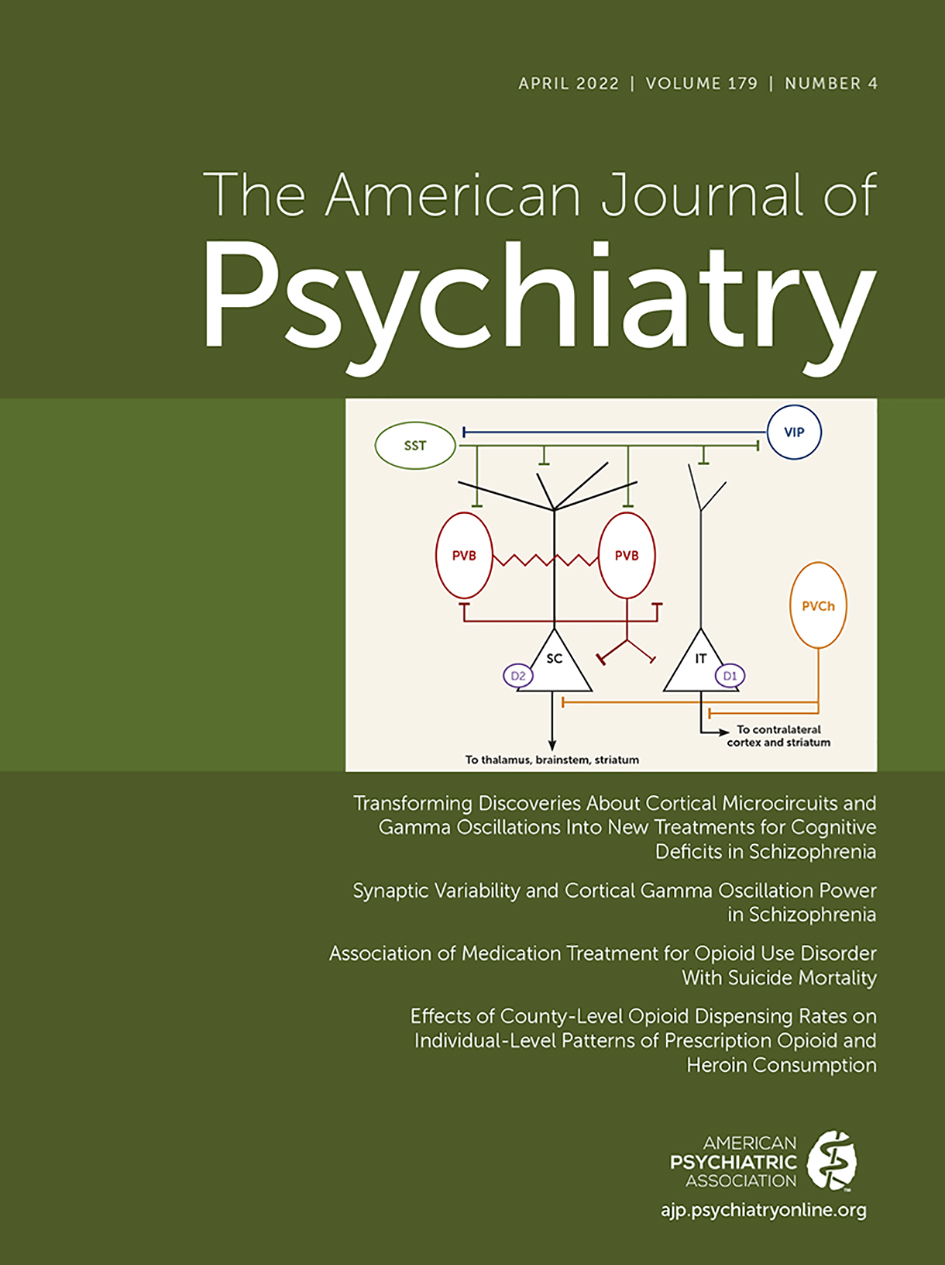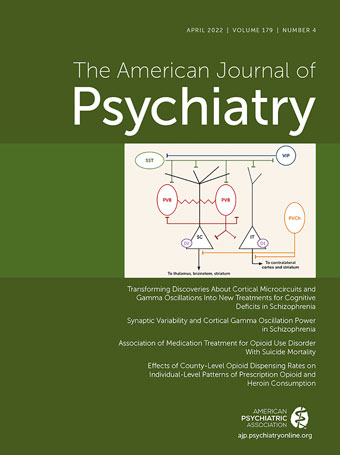Over 20 years ago, 615 people with heroin dependence in Australia joined me in what would become one of our longest follow-up studies (
1,
2). Thankfully, the vast majority survived, and their stories are of ongoing relationships between treatment, mental health, physical health, and substance use disorders. For many, the struggle to live their best life has been a 20-year story of care and courage. A considerable proportion of the 615 people have been able to reduce their heroin use with effective and ongoing treatment. The effectiveness of treatment is also mirrored in controlled trials (
3). A considerable proportion of people were also able to achieve and maintain abstinence without the need for ongoing treatment. A significant proportion continue to use heroin despite being in long-term treatment (
2). Understanding what we can do to prevent this struggle is critical, and providing the best care when prevention is not possible, is essential.
In this issue of the
Journal, Vuolo and Kelly (
4) provide a thoughtful and considered analysis of opioid dispensing in addressing opioid use, harms, and dependence. Their work is very timely since opioid-related mortality and morbidity remain unacceptably high. Both the United States and parts of Europe have experienced increasing rates of use, dependence, and death. Opioids make the single largest contribution to illicit drug-related mortality and morbidity worldwide (
5). In the United States, this had been paralleled by the rapid escalation of prescription opioids over the past 20 years, linked to changes in prescribing practices. The need to pay attention to opioid-related mortality has never been more important; the ongoing drug overdose crisis in the United States (
6) is now coupled with the additional increased social disparities and chronic health concerns resulting from the COVID-19 pandemic (
7,
8). Every day, more and more people are at increased risk (
7).
Changing prescribing behavior through strategies such as recommending alternative, non-opioid-derived pain relievers is one of the solutions posed to reduce opioid use, harms, and dependence. However, understanding the nuanced relationship between opioid dispensing, use, harms, and dependence is critical for confidence in this measure. Importantly, we need to know whether a decreasing opioid prescription dispensing rate is associated with changes in prescription opioid use outcomes; specifically, will an increase in harms result when the dispensing rate is increasing, and a decrease as it declines?
An additional concern about decreasing the availability of prescriptions is that reductions in the circulation of prescription opioids could mean that those with prescription opioid dependence will seek illicit opioids, such as heroin. We need to understand whether this occurs at national levels, and to date, the evidence has been patchy. As Compton et al. (
9) so clearly state, “Some persons certainly use heroin when they are unable to obtain their preferred prescription opioid; however, whether the increases in heroin trends in the overall population are driven by changes in policies and practices regarding prescription opioids is much less clear.” We do not yet know if changes in dispensing rates affect patterns of heroin use. The article by Vuolo and Kelly in this issue provides us with a well-considered analysis that reports that changing opioid dispensing is associated with prescription opioid use, without higher rates of heroin use. This is an important and positive piece in the multifaceted puzzle of this complex and urgent problem.
The investigators examined whether county-level changes in U.S. opioid prescribing rates affect individual-level prescription opioid misuse, frequency of use, and dependence, as well as the outcomes for heroin. They used data from the National Survey on Drug Use and Health, the Centers for Disease Control and Prevention retail opioid prescriptions database, the Prescription Drug Abuse Policy System, and the U.S. Census, bringing together a sample of over 748,000 participants. They applied fixed-effects models and Bayes factors to support evidence for null findings. This is an excellent example of the use of existing data sets to respond to a critical public health question. Importantly, the study found a relationship between the odds of prescription opioid use, frequency of misuse, and dependence, with each being higher per standard deviation increase in the county-level opioid prescribing rate per 100. Further, there was no such association with the three heroin outcomes. Vuolo and Kelly conclude that reductions in opioid prescribing rates have contributed to stemming prior increases in prescription opioid misuse while not increasing heroin use rates and overdoses.
The authors’ use of place-based, county-level information in understanding opioid deaths is a significant and novel contribution to this area. Their findings add strength to the contention of Compton et al. (
9): increases in heroin trends in the overall population that occurred as prescription rates changed may not have been driven by changes in policies and practices regarding prescription opioids. This is, however, as noted by the authors, a study of association: while heroin use is an important outcome, it remains unclear whether other illicit use and harms changed. This will be important to examine in future work, especially given the dynamic nature of this area and the potential for unintended consequences.
The Vuolo and Kelly study relied on repeated cross-sectional data, and the authors were thus not able to examine within-person change. At its heart, it is an observational study of associations, and the authors are clear on this limitation. While the study could not examine within-person change, as our longitudinal study shows (
2), within-person change has many trajectories. Unfortunately, U.S. national-population, geocoded, individual longitudinal data on prescription opioid use and illicit opioid use are not available for a sufficient sample size. Having data like this would be highly informative in such a dynamic and important area of health; for example, a longitudinal cohort could allow early understanding of the impact of opioid dispensing on fentanyl or fentanyl-adulterated heroin, or the relationship and impact of changes in medicinal cannabis policy. While Vuolo and Kelly made outstanding use of existing data sets, the lack of longitudinal data reduces confidence in the conclusions at an individual level.
While this analysis has many strengths, counties are the focus in the study, and they vary significantly in size and number across states. Measuring dispensing rates at this level means that the study could not measure, or control for, within-county-level differentiation. Counties are a significant improvement on the less nuanced state-level dispensing data that have been the focus of previous research, but they still vary. Vuolo and Kelly included a large number of individual county- and state-level measures to control, as best they could, other factors that may affect patterns of use and dependence. Although this is impressive, we are not able to rule out whether another variable led to the change, including changes in the response to surveys, or other cohort differences.
The Vuolo and Kelly article, and the stories of the individuals in our cohort of 600, also emphasizes the importance of treatment availability as we change prescribing so that those who are dependent on prescription opioids have support. Hard-hitting opioid prescription policy changes may have the unintended consequence of stigmatizing opioid prescription use and dependence. Stigma can impede treatment seeking and can lead to social isolation and distress. These can then lead to an increase in the likelihood of ongoing substance use problems (
10). Across the world, only half of all countries provide access to effective treatment options for opioid dependence, and less than 10% of people in need of treatment are able to access it (
11). Even in the best treatment settings in the world, the most evidence-based contemporary interventions for opioid dependence and its common comorbidities are not routinely available (
12). Unfortunately, there are too few medical providers working in substance use treatment and too few qualified to provide medication-assisted treatment to make sure that psychosocial interventions are delivered. While this is improving, there is still a significant treatment gap. Policy and educational initiatives, as examined in the Vuolo and Kelly study, were associated with decreasing prescription opioid use and dependence, but they are only one part of a comprehensive approach. Research and practice focusing on the development and evaluation of treatments specific to prescription opioid dependence and its common comorbidities (e.g., chronic pain, trauma, depression) are still critically needed (
3,
12).
Ultimately it will be a comprehensive approach of policy (prescribing changes), removing the stigma associated with substance use disorders, increasing access to medication-assisted treatment, and widening the availability of naloxone that will be needed to address the opioid crisis. There have been impressive efforts in the United States to increase the availability of naloxone to people at risk for opioid overdose death, including an advisory from the U.S. Surgeon General encouraging individuals to carry naloxone (
13). It will take the combined effort of community members, health care professionals, policy makers, and researchers to respond to the opioid crisis. We need to increase our research on understanding causes (
14), prevention (
4,
15), and effective treatment (
3). We must ensure that when we implement policy changes, like prescribing patterns, we also provide the best evidence-based care for those who need it. Clinicians seeking to ensure the best outcomes for patients with opioid dependence will be striving across all of these areas.

